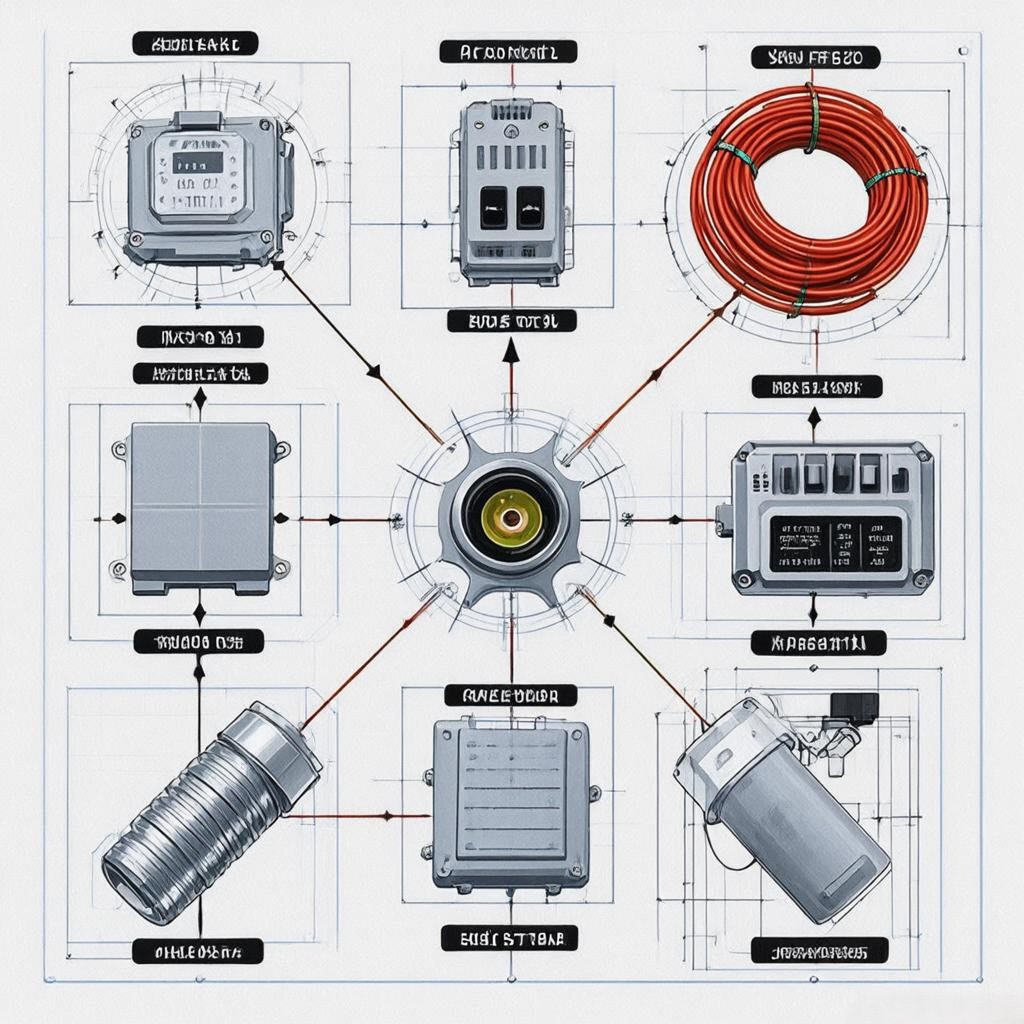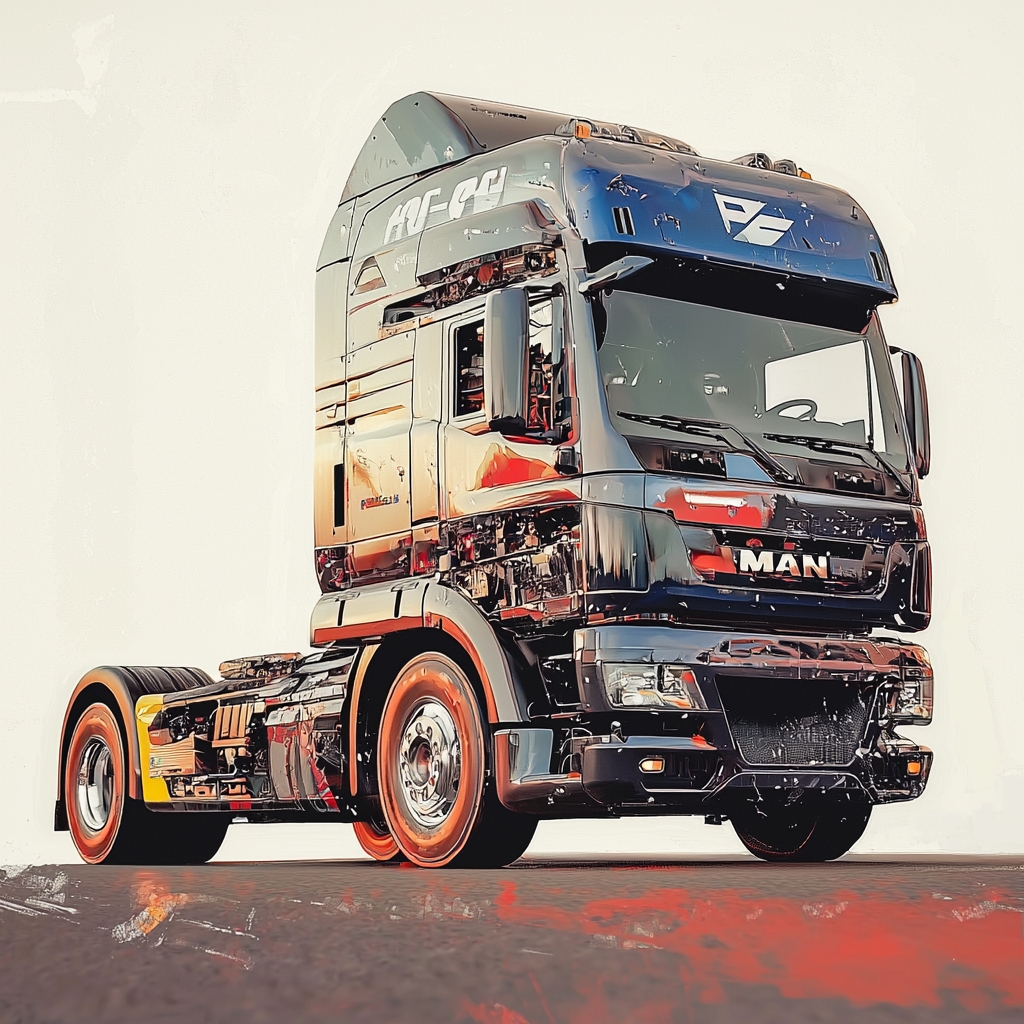Fuel injection systems represent the technological backbone of modern internal combustion engines, replacing traditional carburetors with precise, electronically controlled fuel delivery mechanisms. These systems rely on a complex network of precisely engineered components to optimize fuel atomization, mixture formation, and combustion efficiency. This comprehensive technical analysis explores the complete ecosystem of injection parts, their functional interrelationships, and how cutting-edge innovations are shaping the future of internal combustion engine performance.




1. Fundamental Principles of Fuel Injection Systems
Modern fuel injection systems have revolutionized engine performance by replacing carbureted fuel delivery with precise, electronically controlled fuel atomization. These systems offer several critical advantages:
- Precise fuel metering: ±1% accuracy in fuel delivery
- Optimized combustion: Improved air-fuel ratio control
- Emission reduction: Lower HC, CO, and NOx emissions
- Throttle response: Instantaneous fuel delivery when needed
Technical specifications:
- Injection pressure: 100-3,000 bar (1450-43,500 psi)
- Response time: <0.1ms for electronic injectors
- Flow rate accuracy: ±0.5% of nominal value
- Operating temperature: -40°C to +150°C
Industry significance: Fuel injection systems account for 20-30% of engine development costs but deliver 50% of the performance improvements in modern engines, with fuel economy gains of 15-30% compared to carbureted systems.
2. Core Injection Components and Functional Architecture
2.1 High-Pressure Fuel Pump
Mechanical design:
- Plunger-type pumps: Radial or axial configuration with 6-12mm plunger diameter
- Cam-driven operation: Precision-ground camshafts with 0.01mm surface finish
- Pressure regulation: Spring-loaded spill valves or electronic control
Material innovations:
- Hardened steel components: Surface hardness 60-65 HRC
- Wear-resistant coatings: Chrome-nitride or diamond-like carbon
- Precision machining: Tolerances within 0.001mm
Performance metrics:
- Maximum pressure: 2,000-3,000 bar (29,000-43,500 psi)
- Flow rate: 100-500 cc/revolution
- Efficiency: >85% hydraulic efficiency
2.2 Common Rail System Components
Rail design:
- High-pressure reservoir: Seamless steel tubing with 50-100MPa burst pressure
- Pressure stabilization: Accumulator volumes of 50-200cm³
- Leak prevention: Double-sealing connections with metal gaskets
Pressure sensors:
- Piezoresistive elements: 0.1% full-scale accuracy
- Temperature compensation: ±2°C accuracy
- Response time: <1ms
Electronic control unit (ECU):
- 32-bit microcontrollers: 200MHz processing power
- Injection timing resolution: 0.1° crank angle
- Fault diagnostics: ISO 14229 (UDS) compliance
2.3 Fuel Injectors
Injector types:
- Solenoid-operated: 12V/24V operation with 0.1ms response
- Piezo-electric: 0.05ms response with 1% flow accuracy
- Unit injector: Combined pumping and injection function
Nozzle designs:
- Multi-hole configurations: 4-12 holes with 0.1-0.2mm diameter
- Hydraulic flow optimization: Turbulence generators for better atomization
- Heat-resistant materials: Stellite or Inconel alloys
Spray characteristics:
- Sauter mean diameter: 10-30μm for gasoline, 20-50μm for diesel
- Penetration length: 50-200mm depending on injection pressure
- Spray angle: 120-150° cone angle
3. Advanced Injection Technologies and Control Strategies
3.1 Multiple Injection Strategies
Injection event types:
- Pilot injection: 1-5% of total fuel, 1-2ms before main injection
- Main injection: Primary combustion event (80-90% fuel)
- Post-injection: 5-10% fuel for aftertreatment heating
Timing control:
- Crank angle resolution: 0.1° precision
- Injection rate shaping: Variable opening/closing profiles
- Pilot-main-post synchronization: ±0.5° timing accuracy
Benefits:
- Noise reduction: 3-5dB(A) lower combustion noise
- Emission control: 20-40% lower NOx and PM emissions
- Efficiency improvement: 2-5% better fuel economy
3.2 Adaptive Fuel Metering
Sensor integration:
- Mass air flow (MAF) sensors: ±1% accuracy
- Manifold absolute pressure (MAP) sensors: ±0.5% full scale
- Coolant temperature sensors: ±1°C accuracy
Control algorithms:
- Closed-loop lambda control: ±0.01 A/F ratio adjustment
- Fuel rail pressure control: ±1% setpoint accuracy
- Transient compensation: Predictive fueling during load changes
Learning capabilities:
- Adaptive knock control: Cylinder-specific timing adjustments
- Fuel quality adaptation: Octane number sensing
- Aging compensation: Injector flow rate correction
3.3 Cold Start and Warm-Up Strategies
Specialized injection modes:
- Split start injection: Multiple small injections for reliable ignition
- Increased injection duration: 2-3x normal pulse width
- Retarded timing: Lower combustion temperatures
Auxiliary systems:
- Glow plugs: 1,200°C tip temperature for diesel engines
- Secondary air injection: For faster catalyst light-off
- Fuel heater elements: Prevent wax crystallization in biodiesel
Performance metrics:
- Start time: <2 seconds at -30°C
- Emissions during warm-up: 50% lower HC than uncontrolled systems
- Fuel consumption penalty: <5% during cold operation
4. System Integration and Engine Applications
4.1 Gasoline Direct Injection (GDI) Systems
High-pressure components:
- Pressure pumps: 100-350 bar operating pressure
- Common rails: Stainless steel tubing with 70MPa burst pressure
- Injectors: 6-hole designs with 0.12mm diameter orifices
Combustion chamber design:
- Tumble flow optimization: Intake port shaping
- Piston crown geometry: Re-entrant bowl designs
- Spark plug placement: Central or offset configurations
Emission control integration:
- Gasoline particulate filters (GPF): 90% PM capture efficiency
- Three-way catalysts: Close-coupled positioning
- Oxygen sensor arrays: Upstream and downstream monitoring
4.2 Diesel Common Rail Systems
High-pressure generation:
- Radial piston pumps: 1,800-2,500 bar maximum pressure
- Pressure accumulators: 100-200cm³ volume
- Pressure limiting valves: 2% setpoint accuracy
Injector technologies:
- Piezo-actuated injectors: 7-hole designs with 0.1mm nozzles
- Rate shaping capability: Variable injection rate profiles
- Hydraulic amplification: 1:5 pressure multiplication
Aftertreatment coordination:
- Exhaust gas recirculation (EGR): Up to 50% flow rates
- Selective catalytic reduction (SCR): AdBlue dosing control
- Diesel oxidation catalysts (DOC): Light-off temperature management
4.3 Alternative Fuel Injection Systems
Natural gas systems:
- High-pressure tanks: 200-300 bar storage
- Pressure regulators: 5-10 bar outlet pressure
- Injectors: Modified gasoline injectors with wider pulse widths
Hydrogen fuel systems:
- Direct injection: 350-700 bar pressures
- Cryogenic storage: -253°C liquid hydrogen
- Specialized materials: Titanium alloys for hydrogen compatibility
Ethanol blends:
- Corrosion-resistant components: Stainless steel fuel lines
- Higher flow rates: 10-15% increased injector capacity
- Cold start aids: Heated fuel filters
5. Design Challenges and Engineering Solutions
5.1 High-Pressure System Reliability
Material solutions:
- Boron steel components: Yield strength >1,200 MPa
- Diamond-like carbon coatings: 0.1μm thickness for wear resistance
- Precision honing: Surface finish Ra <0.1μm
Leak prevention:
- Metal-to-metal sealing: Braze joints with 100% leak testing
- O-ring selection: Fluorocarbon materials for fuel compatibility
- Pressure testing: 150% working pressure validation
Thermal management:
- Cooling circuit integration: Jacketed high-pressure pumps
- Heat shields: Aluminum alloys for thermal insulation
- Temperature sensors: Redundant monitoring at critical points
5.2 Electromagnetic Compatibility (EMC)
Design measures:
- Shielded connectors: 360° braided shielding
- Filtered power supplies: Common-mode chokes
- Grounding schemes: Single-point grounding for EMI control
Testing standards:
- ISO 11452-2: Bulk current injection
- ISO 7637-2: Transient immunity
- CISPR 25: Radiated emissions
Performance metrics:
- Shielding effectiveness: >60dB at 100MHz
- Transient immunity: ±25kV ESD protection
- Emission levels: <54dBμV/m at 30-1000MHz
5.3 Fuel Quality and Contamination Control
Filtration systems:
- Primary filters: 10-30μm nominal filtration
- Secondary filters: 2-5μm absolute filtration
- Water separators: Coalescing element designs
Material compatibility:
- Biodiesel resistance: Fluorinated elastomers
- Ethanol compatibility: Stainless steel wetted parts
- Sulfur resistance: Specialized plating for high-sulfur fuels
Contamination monitoring:
- Particle counters: Online monitoring systems
- Water detection sensors: Capacitive or optical types
- Fuel quality sensors: Dielectric constant measurement
6. Testing and Validation Methodologies
6.1 Component-Level Testing
High-pressure testing:
- Burst pressure testing: 150% working pressure
- Leak testing: Helium mass spectrometry
- Fatigue testing: 100 million cycles at rated pressure
Injector testing:
- Flow rate calibration: ±0.5% accuracy
- Spray pattern analysis: High-speed photography
- Opening pressure verification: Deadweight testers
Sensor validation:
- Static calibration: Reference standards comparison
- Dynamic response: Step input testing
- Environmental testing: -40°C to +125°C
6.2 System-Level Validation
Engine dynamometer testing:
- Brake specific fuel consumption (BSFC): ±1% measurement accuracy
- Emission measurements: CVS bag sampling
- Transient response: Step load changes
Vehicle testing protocols:
- Cold start tests: -30°C ambient conditions
- Drive cycle validation: WLTP and FTP-75
- Altitude testing: Up to 3,000m elevation
Endurance testing:
- 1,000-hour durability: Continuous operation
- 100,000km road testing: Real-world conditions
- Thermal cycling: -40°C to +125°C, 1,000 cycles
6.3 Virtual Validation
Simulation tools:
- Computational fluid dynamics (CFD): Spray and combustion modeling
- Finite element analysis (FEA): Structural integrity
- System simulation: AMESim or GT-Power
Test scenarios:
- 10,000+ virtual test cases covering all operating conditions
- Edge case testing: Extreme loads and temperatures
- Long-term durability simulation: 10-year equivalent cycles
7. Market Trends and Future Developments
7.1 Electrification and Hybridization
Key innovations:
- 48V mild hybrid integration: Electrically-assisted GDI
- High-pressure electrification: Electrically-driven high-pressure pumps
- Predictive control algorithms: Using route data and traffic patterns
Technical challenges:
- System integration: Combining electric and mechanical components
- Energy management: Optimizing battery and fuel usage
- Control complexity: Coordinating multiple power sources
7.2 Advanced Materials and Manufacturing
Innovative approaches:
- 3D-printed manifolds: Complex flow paths
- Carbon fiber reinforced polymers: Lightweight components
- Additive manufacturing: Rapid prototyping of new designs
Sustainability focus:
- Recyclable materials: End-of-life considerations
- Energy-efficient manufacturing: Reduced carbon footprint
- Smart materials: Self-diagnostic capabilities
7.3 Smart and Connected Injection Systems
Emerging technologies:
- Over-the-air (OTA) updates: Software improvements without service visits
- Digital twin technology: Predictive maintenance and performance monitoring
- AI-based learning algorithms: Personalized fueling profiles
User benefits:
- Remote diagnostics: Fleet management integration
- Customizable settings: Driver preference storage
- Proactive alerts: Maintenance notifications based on usage
8. Case Studies: Real-World Implementations
Case Study 1: Premium Gasoline Engine GDI System
A European luxury car manufacturer implemented a high-pressure GDI system in their flagship model, achieving:
- 15% improvement in fuel economy
- 20% lower CO2 emissions
- Enhanced throttle response (0.2s faster acceleration)
Case Study 2: Heavy-Duty Diesel Common Rail System
A global truck manufacturer upgraded to a next-generation common rail system, resulting in:
- 5% better fuel efficiency
- 40% reduction in particulate emissions
- Extended injector lifespan (2x longer service intervals)
Conclusion: The Precision Heart of Modern Engines
Fuel injection parts represent the critical interface between electronic controls and combustion processes, combining mechanical precision with advanced electronics to deliver optimal engine performance. As vehicles evolve toward electrification and stricter emission standards, these components will continue adapting to meet new challenges while maintaining their core function of precise fuel delivery.
Key takeaways:
- Modern injection systems combine high-pressure pumps, rails, and injectors with sophisticated electronic controls
- Advanced materials and manufacturing enable higher pressures and finer atomization
- System integration with electrification requires new engineering approaches
- Sustainability and digitalization are transforming injection system design
Final thought: In the era of downsizing and emission reduction, fuel injection parts have become the most critical components for engine performance and efficiency. The next generation of these systems will need to balance unprecedented precision requirements with the demands of hybridization, alternative fuels, and environmental sustainability, making them one of the most exciting areas of automotive engineering innovation today.
Call to Action
🔧 Upgrading your engine’s fuel system?
⚙️ Explore our advanced injection components for improved performance and efficiency
📊 Request technical specifications and performance data for your specific application
#FuelInjection #EngineTechnology #AutomotiveEngineering #EmissionsControl #ADAS #Electrification #SmartMobility #FutureOfTransportation #FunctionalSafety #AdvancedManufacturing



